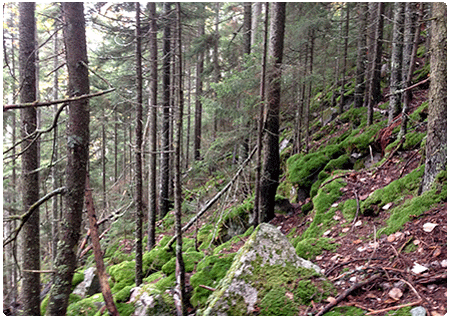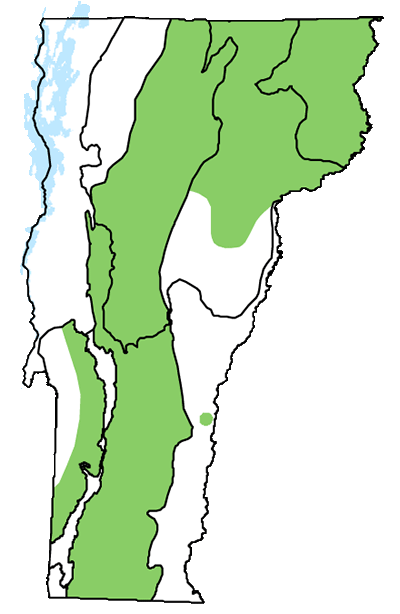Ecology and Physical Setting
With their huge boulders, hidden crevices, and twisted trees, Boreal Talus Woodlands are difficult places to walk through. Trees are the dominant vegetation, but they are scattered and are never dense enough to form a closed canopy. This community occurs in the colder areas of the state, such as at high elevations and in cold valleys.
The formation of talus, or areas of rockfall, is discussed in the section on Open Upland Communities. Most large talus areas have some open talus and some talus woodland. Talus woodlands generally occur at the bases of open talus areas, where soil has accumulated in crevices between rocks, allowing trees to root and grow. Trees can also grow in the small amount of soil material that has accumulated on the rocks and boulders themselves. In these situations, trees do not grow tall, straight, or fast, but instead are short and often twisted. High winds, ice damage, and rockfall are natural processes that add to the stress on plants, causing treefall and limb damage. Many of these woodlands burned along with adjacent forests, when human-caused fires swept through Vermont in the late 19th and early 20th centuries after heavy logging, but natural fires are rare.
Vegetation
Trees are scattered, small, and poorly formed. Heart-leaved paper birch, yellow birch, and red spruce are characteristic species in the low, open canopy. Shrubs, especially mountain maple, are common, making up a significant portion of the vegetation in these communities. Herb diversity is low. A few species, like Appalachian polypody, can persist on the rocks themselves, but most vascular plants are found between boulders where soil has accumulated. Lichens are well adapted to the open rock in Boreal Talus Woodlands, and they are often abundant.
Wildlife Habitat
These cool, rocky slopes provide important denning sites for porcupines and bobcats. Two rare, small mammals are also found in Boreal Talus Woodlands—rock voles are mostly vegetarian and feed on berries, while long-tailed shrews are insectivorous.
Successional Trends
 Boreal Talus Woodlands, in a sense, are in a perpetual state of early succession since treefall in the unstable soils is common. Some Boreal Talus Woodlands may still be recovering from the massive fires of 100 years ago, which were caused by heavy logging and the accumulation of branches left behind. In any case, early-successional species include pin cherry, yellow birch, and heart-leaved paper birch. Less disturbed Boreal Talus Woodlands are likely to have more red spruce and less heart-leaved paper birch.
Boreal Talus Woodlands, in a sense, are in a perpetual state of early succession since treefall in the unstable soils is common. Some Boreal Talus Woodlands may still be recovering from the massive fires of 100 years ago, which were caused by heavy logging and the accumulation of branches left behind. In any case, early-successional species include pin cherry, yellow birch, and heart-leaved paper birch. Less disturbed Boreal Talus Woodlands are likely to have more red spruce and less heart-leaved paper birch.
Related Communities
- Cold Air Talus Woodland is found at the base of open talus areas where consistent cold temperatures occur, resulting from cold air drainage. It is distinguished by the presence of Labrador tea, black spruce, and mosses that indicate cold conditions.
- Open Talus is an open community, often devoid of vascular vegetation and often adjacent to Boreal Talus Woodland.
- Northern Hardwood Talus Woodland is found at lower elevations. Sugar maple and yellow birch are the dominant trees.
Conservation Status and Management Considerations
This is an uncommon community in Vermont and all examples are small. Most are relatively undisturbed by humans, since logging, road building, and other activities are difficult on these steep, rocky slopes.
Distribution/Abundance
Boreal Talus Woodlands are found in all regions of the state except the Champlain Valley, Champlain Hills, and Vermont Valley. They are found throughout the northeastern United States, New Brunswick, Nova Scotia, and parts of Québec.
Characteristic Plants
Trees
Abundant Species
Heart-leaved paper birch – Betula cordifolia
American mountain ash – Sorbus americana
Red spruce – Picea rubens
Yellow birch – Betula alleghaniensis
Occasional to Locally Abundant Species
Balsam fir – Abies balsamea
Shrubs and Vines
Occasional to Locally Abundant Species
Mountain maple – Acer spicatum
Skunk currant – Ribes glandulosum
Striped maple – Acer pensylvanicum
Red-berried elder – Sambucus racemosa
Virginia creeper – Parthenocissus quinquefolia
Herbs
Occasional to Locally Abundant Species
Appalachian polypody – Polypodium appalachianum
White wood aster – Eurybia divaricata
Fringed bindweed – Fallopia cilinodis
Hairgrass – Deschampsia flexuosa
Marginal wood fern – Dryopteris marginalis
Bryophytes and Lichens
Moss – Schistidium apocarpum
Rock tripe – Umbilicaria spp.
Associated Animals
Smoky shrew – Sorex fumeus
Southern red-backed vole – Myodes gapperi
Porcupine – Erethizon dorsatum
Bobcat – Lynx rufus
Rare and Uncommon Animals
Long-tailed shrew – Sorex dispar
Rock vole – Microtus chrotorrhinus
Places to Visit
Mount Horrid, Rochester and Goshen, Green Mountain National Forest
Smugglers Notch, Cambridge, Mount Mansfield State Forest, Vermont Department of Forests, Parks, and Recreation
